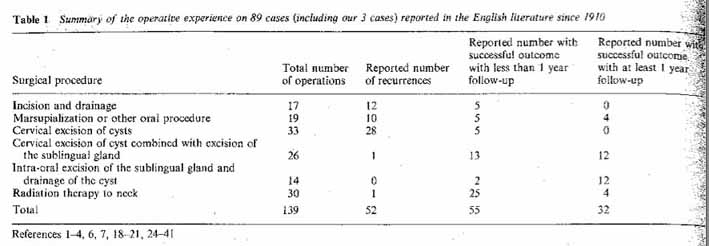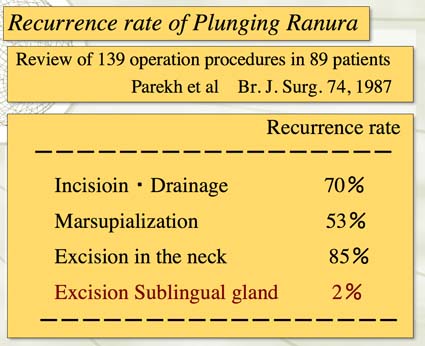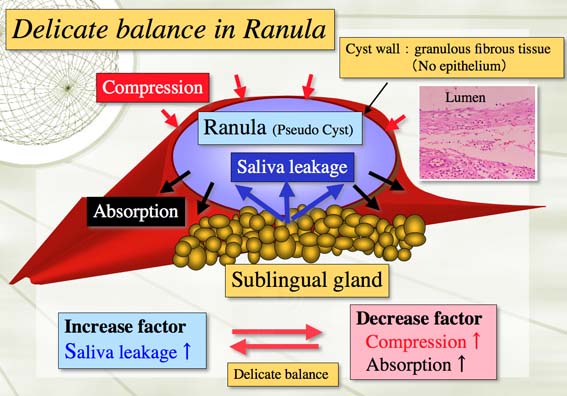

1, Ranula cannot be cured
if it was completely removed.
It is well known that recurrence sometimes occurs after surgery.
Till ten years ago, I had no doubt that it was from unskillful
surgery and if ranula was completely removed ranula would be completely
cured.
The followings are Table 1 of Dr. Parekh's
paper in British Journal of Surgery 1987.

The following is recurrence rate.

Parekh reviewed about 139 surgeries of 89 cases with plunging ranula since 1910. Recurrence rate was 70 % by incision and drainage, 53 % by marspialization. I insist that this is recurrence rate not cure rate. And, I was surprised that recurrence rate by cervical excision was 85 %. Of course, the point insisted in this paper was that recurrence rate was markedly reduced to 2 % by excision of sublingual gland. There were old cases in this paper, radiation is included to treatment. Recurrence rate of radiation therapy was 3 %.
2, What
is ranula?
I first submitted an article about OK-432 therapy for ranula to
an American journal in 1998. In that paper, I wrote that "The
cyst wall of ranula is very thin, so complete removal is difficult.
Because of this, recurrence sometimes occurs". The referee's
comment was "ranula is not true cyst, is pseudo cyst. As
treatment of pseudo cyst, removal of the cyst is not needed, removal
of sublingual gland is needed". After that, I changed my
understanding about ranula.

There is thin cyst wall in ranula, but there is no epithelium
in the cyst wall. Ranula is pseudo cyst. True cyst has epithelium.
For example, median cervical cyst has columnar epithelium and
lateral cervical cyst has squamous epithelium. Cyst wall of ranula
is almost consisted by fibrous tissue. Ranula is mucous saliva
leakage from sublingual gland. Some investigators thought that
inflammation around saliva leakage makes granulation and it change
to fibrous tissue. I am now thinking that a living body react
disorders happened in its body surely profitable to itself. The
fluid leaked is saliva. Saliva contains digestive enzymes like
amylase and antibacterial proteins like lactoferrin. They are
not good for surrounding tissues. As a self protection, a living
body may make border "cyst wall" between saliva and
surrounding tissue. Another organ that resembles salivary gland
is pancreas. As you know, cysts are frequently occurred in pancreas.
These are thought to occur by destruction of duct and 90 % of
pancreatic cyst is pseudo cyst.
The factor that
ranula becomes big is increase of saliva leakage. The factors
thoset ranula becomes small are compression from the surrounding
tissue and absorption of cyst fluid. Ranula is maintained by this
delicate balance. The important point of this model is that leakage
of the saliva is continuing if ranula exists. If the saliva leakage
stopped, ranula would spontaneously cure.
3, Treatment of Ranula
At first, I will think about removal of ranula. It is very difficult
operation. After surgery, ranula would cure if saliva leakage
stopped during operation. But, if saliva leakage would not stop,
ranula would recur. Total removal of ranula does not promise complete
cure. The factor that related recurrence is only stop leakage
or not. Please think about pools next to river or pools around
rapture of water pipe. If the pools were constructed to remove,
they will be made again as far as water flows contenueing. In
Parekh's paper, incredible recurrence rate 85 % was reported after
cervical excision of plunging ranula.
My
image of OK-432 inracystic injection therapy is like repair puncture
spray. If OK-432 was injected into the cyst, strong inflammation
will occur and some viscous inflammatory products like fibrin
was produced. These inflammatory products will adhere the leakage
point and stop leak. Another image is putty up ruptured water
pipe. If the the power of leakage was strong, the saliva leak
does not stop. This is the reason why OK-432 therapy must be repeated
in some cases.
Removal of sublingual gland is
a operation that remove the source of saliva. Theoretically, no
recurrence. Parekh reported that recurrence rate was 2 % after
removal of sublingual gland. So, the trump card of operation for
ranula is removal of sublingual gland.
Parekh
also reported that recurrence rate after radiation was 3 %. Of
course, now radiation to benign disease is prohibited. I think
radiation to salivary gland is the same effect of removal of sublingual
gland. We often experienced severe dryness of mouth occurs after
radiation to Head & Neck cancer. The function of salivary
gland is totally lost. This means the same effect of removal of
sublingual gland. From above mentioned reason, I am thinking the
treatment of ranula should be as follows.
The strategy
for treatment of plunging
ranula is
(1) Repeat OK-432 intracystic
injection (4 to 5 times).
More than 90 % will be cured by this treatment.
If OK-432 treatment was not effective
(2) Removal of sublingual
gland(from mouth, no need of removal of ranula)
should be preferable.
At meeting of stomatopharyngology
Japan 2006, very important report for me was reported. The report
was that they operated "removal of sublingual gland "
2 cases after OK-432 therapy. There were no interference like
adhesion, they could be operated like normal patient. I think
from this report there is no reason why hesitating OK-432 therapy.
In 2009, very great work about treatment of
ranula was reported from North Carolina University (Reference
15). In the U.S.A., OK-432 was not approved yet. So, this report
was a comparison of operations. They concluded that the most preferable
treatment of ranula was removal of the ipsilateral sublingual
gland and evacuation of the ranula. Excising ranula is unnecessary.
From this report, also in the U.S.A., standard treatment algorithm
of ranula was not established. Many physicians are treating ranula
by their own philosophy. I think this is from plunging ranula
is rare and not fatal disease.
Please Click here to go to English Page with frame (If you can't see frame, click it)